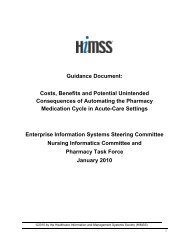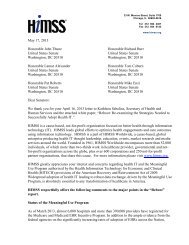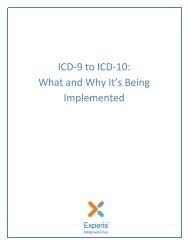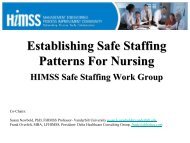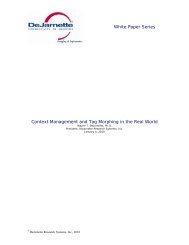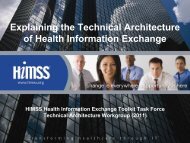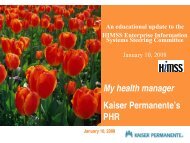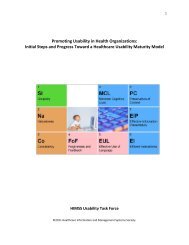CSC White Paper - Curing Operational Inefficiency How real ... - himss
CSC White Paper - Curing Operational Inefficiency How real ... - himss
CSC White Paper - Curing Operational Inefficiency How real ... - himss
Create successful ePaper yourself
Turn your PDF publications into a flip-book with our unique Google optimized e-Paper software.
<strong>Curing</strong> <strong>Operational</strong> <strong>Inefficiency</strong><br />
<strong>How</strong> <strong>real</strong>-time locating technology brings a cure to asset<br />
management headaches<br />
©2010 Intelligent InSites, Inc. All rights reserved.<br />
TM<br />
Enabling the Real-Time Enterprise<br />
Part of the Intelligent InSites<br />
<strong>White</strong> <strong>Paper</strong> Series.
...the importance of<br />
finding equipment or<br />
inventory increases<br />
even more when it’s<br />
needed to provide timecritical<br />
care...<br />
When asked to perform a “health screening” of an<br />
average hospital, you would most likely come back<br />
with a diagnosis of “chronic operational inefficiency.”<br />
The symptoms of this syndrome are easy to detect, even<br />
by an inexperienced specialist in the field of Lean or Six<br />
Sigma. Thousands of assets, such as IV pumps, wheelchairs,<br />
and other medical equipment move constantly<br />
throughout the facility. <strong>How</strong> easy it is for staff to locate<br />
them, know their status, or the level of their utilization?<br />
As suspected, the root problem of operational inefficiency lies in the<br />
limited visibility into operational performance. This white paper evaluates<br />
the most common problems in the area of asset management<br />
and the way Real-Time Locating Systems (RTLS) can address them.<br />
The nurse’s headache: “Where is the IV pump?”<br />
Hospital employees spend 23% to 32% of their time searching for<br />
123<br />
equipment – that’s more than two hours per shift per nurse!<br />
Although they may not see this as wasted time, this translates to<br />
less time spent with patients. The importance of finding equipment<br />
or inventory increases greatly when it’s needed to provide<br />
time-critical care. In situations such as cardiopulmonary arrest, the<br />
defibrillator, medications, and other resuscitation materials need to<br />
be available immediately in order to facilitate successful recovery of<br />
the patient, giving no room for unexpected searches or checking for<br />
clean/dirty status.<br />
The symptoms of untraceable equipment can be easily solved by<br />
utilizing an RTLS system, which includes tags attached to the asset.<br />
By using a signal transmitted via infrared, RF, or ultrasound<br />
waves, the tagged items can be located immediately anywhere<br />
within the facility. In addition, staff can easily identify the current<br />
status of assets such as ‘in-use’ or ‘available’, which facilitates instant<br />
locating of the nearest available item. This in turn increases<br />
staff productivity and satisfaction as their time can be devoted to<br />
activities more appropriate to their skills, expertise, and passion.<br />
1. Gurse, Alys P & Carayon, Pascale (2007). “Performance Obstacles of Intensive Care Nurses.” Nursing Research 56, 185-194.<br />
2. http://www.nursingtimes.net/nurses-waste-an-hour-a-shift-finding-equipment/1987381.article<br />
3. Gurses, A.P. and Carayon, P. “Impact of performance obstacles on workload, quality of working life, and quality and safety of care among intensive care<br />
nurses”. Health Services Research. April 2009 v44 i2 p422(22).<br />
©2010 Intelligent InSites, Inc. All rights reserved.<br />
1
The purchasing manager’s headache: “Do we <strong>real</strong>ly need to order another one?”<br />
It is not unusual for a medical staff to hide equipment so they can<br />
have immediate access to it when needed. Although employees<br />
do it with good intentions, striving to provide better patient care and<br />
save time, it too often becomes counterproductive as it causes overpurchasing<br />
or unnecessary renting in order to keep the minimum<br />
level on hand. Many assets also leave the department or facility and<br />
never return due to being borrowed, stolen, or just unintentionally<br />
misplaced by staff or taken by patients.<br />
The symptoms of underutilized equipment can be dramatically reduced<br />
by analyzing the data collected by the RTLS system. By knowing<br />
which assets are being used and which are idle, you can put a<br />
stop to unnecessary purchases or renting expenses. This also<br />
lowers the cost of operations and increases the utilization rate of<br />
the hospitals current equipment.<br />
...the symptoms of<br />
inappropriately<br />
maintained equipment<br />
can be easily eliminated<br />
by using an RTLS<br />
system...<br />
The biomedical engineer’s headache: “We need to fix what?”<br />
In order to provide the highest standards of patient care and safety,<br />
healthcare facilities need to keep the equipment in tip-top condition,<br />
conduct regular preventive maintenance of the equipment,<br />
react immediately to any recall situation, and have a handle on any<br />
expired inventory items. Often times, the service team simply cannot<br />
locate the equipment scheduled for maintenance, which can result<br />
in lost warranty or not meeting regulatory requirements. Quite often<br />
just finding the piece of equipment that needs to be repaired or<br />
cleaned poses a challenge to the engineering team.<br />
The symptoms of inappropriately maintained equipment can be easily<br />
eliminated by using an RTLS system. The deployment of the <strong>real</strong>time<br />
locating technologies can not only reduce the time staff needs<br />
to perform maintenance, repair, or replacement, but it will also help<br />
the facility adhere to the requirements mandated by equipment<br />
manufacturers, or accreditation organizations, such as The Joint<br />
Commision.<br />
Additionally, the ‘location-enabled’ solution allows care providers to<br />
automatically notify maintenance staff when a piece of equipment<br />
needs repair by simply pressing a button on the asset tag. The work<br />
order is then automatically created, and the exact ID and location of<br />
the tag is communicated to the staff for an expedited response. This<br />
ensures a better process for the requested repair, and more efficient<br />
use of staff time.<br />
©2010 Intelligent InSites, Inc. All rights reserved.<br />
2
The COO’s headache: “<strong>How</strong> do I know what’s happening right now?”<br />
If you ask the typical hospital CFO if they have a view into their hospital’s<br />
financial status, they would most likely be able to show you a<br />
computer dashboard flashing with updated financial metrics and Key<br />
Performance Indicators. <strong>How</strong>ever, most hospital COO’s are lacking the<br />
visibility into operational performance and are still using out-of-date<br />
data that is often manually collected to base their decisions. Additional<br />
struggles come with the need to compare data between different<br />
departments across the hospital, or the entire healthcare network.<br />
The symptoms of business intelligence blindness can be eliminated<br />
by deploying a single system capable of effortlessly collecting<br />
and analyzing data from location-enabled systems and<br />
other healthcare information systems across the entire enterprise,<br />
thus gaining <strong>real</strong>-time, hospital-wide visibility into operations.<br />
This enables timely and sound business decisions, resulting<br />
in more efficient deployment of resources and increased<br />
profitability. Furthermore, CIO’s highly value a unified platform approach,<br />
which allows collected data to be leveraged in many ways.<br />
The patient’s headache: “I need to wait how long?”<br />
Most importantly, the problem of locating available medical assets<br />
not only lowers staff productivity, but it directly impacts<br />
patient satisfaction. Patients become frustrated as the search for<br />
equipment adds extra minutes to their wait times, which in turn affects<br />
the opinion they have about the quality of services provided to them.<br />
The symptoms of long wait times can be significantly reduced by ensuring<br />
the medical staff have the tools allowing them to track equipment<br />
continuously in <strong>real</strong>-time, without any additional effort on their part,<br />
resulting in a less hectic environment and more patient-focused care.<br />
In conclusion there is a simple, effective, and proven cure for<br />
chronic operational inefficiency. Real-time locating solutions are<br />
available for your hospital use, and the best thing of all - you can<br />
self-prescribe it...<br />
©2010 Intelligent InSites, Inc. All rights reserved.<br />
3
Dr. Raymond Gruby – Chief Medical Officer<br />
With more than 30 years of hands-on medical experience<br />
as an orthopedic surgeon, Dr. Gruby brings a wealth of<br />
<strong>real</strong>-world healthcare experience that allows Intelligent InSites<br />
to create healthcare-focused solutions that deliver value from<br />
day one. Dr. Gruby is a recognized expert in streamlining healthcare<br />
processes through the use of <strong>real</strong>-time locating technologies<br />
and advanced workflow software applications.<br />
You can contact him at raymond.gruby@intelligentinstes.com<br />
About Intelligent InSites<br />
Intelligent InSites provides <strong>real</strong>-time enterprise visibility and automation<br />
solutions that transform the healthcare industry by dramatically<br />
driving down costs while improving the level of care and<br />
patient safety. By providing a single software platform capable of<br />
streamlining dozens of systems and processes using <strong>real</strong>-time<br />
location and sensory data continuously collected throughout<br />
the enterprise, Intelligent InSites helps healthcare organizations<br />
gain visibility into their operations and make profound improvements<br />
in the area of patient safety, workflow optimization,<br />
asset and inventory management, and regulatory compliance.<br />
For more information about Intelligent InSites and its <strong>real</strong>-time location and condition-sensing solution --<br />
InSites Enterprise Visibility Platform<br />
visit www.IntelligentInSites.com or call 1-866-520-9117.<br />
©2010 Intelligent InSites, Inc. All rights reserved.<br />
4




